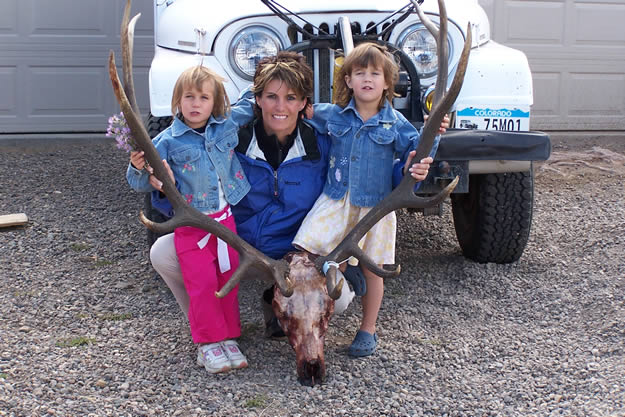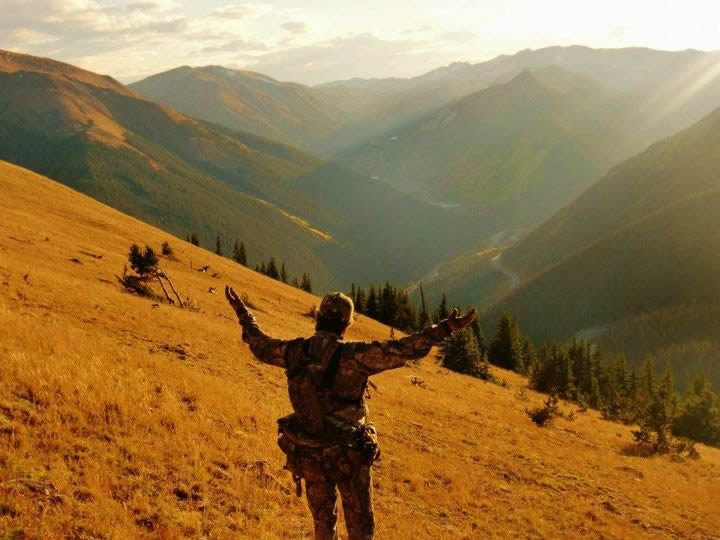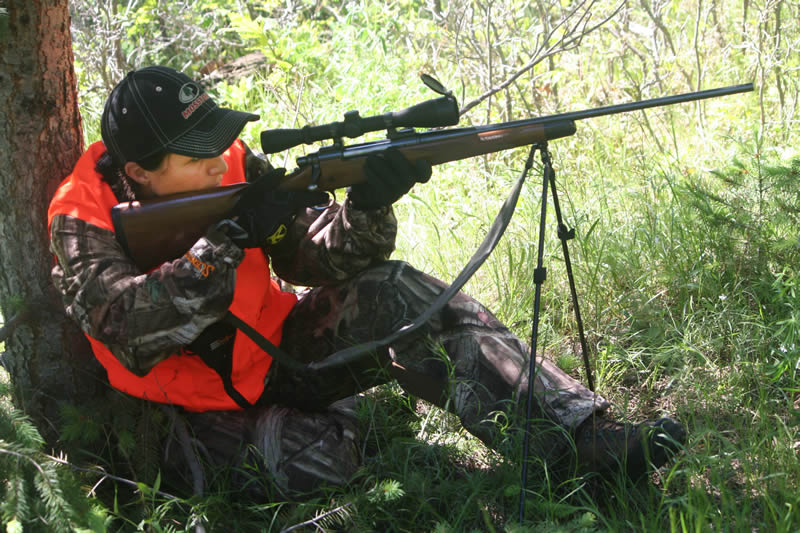
Editor’s Note: Mossy Oak Pro Lisa Thompson of Littleton, Colorado, who’s married to her hunter husband Keith and has twin daughters, is one of the most-knowledgeable and physical elk hunters you'll ever meet. She’s also a mom, a business woman, a basketball player and an expert woodswoman. A member of Cabela’s and Nock On, that produces lighted nocks for arrows, pro staffs, Thompson’s successful at taking big bulls on public lands. If you'll apply the tips and tactics she suggests this week, you’ll have a much-greater chance of filling your elk tag on public lands this fall instead of returning home with an elk tag in your pocket.
 I used to always hunt with my brother, my husband or my brother-in-law. They always would bugle, and I’d cow call. When I started hunting with Donnelle, I discovered that she also liked to bugle. So, I let her bugle, because I really didn’t know how to bugle. Then I usually followed her bugle with a series of cow calls and some hyper hot cow calls. I have a lot of confidence in my ability to call in bulls by only cow calling, because I've been successful calling in a lot of bulls for myself, my friends and my family. Another thing I've learned, especially hunting Colorado’s public lands and on public lands in other states, is that bugling is effective for locating a bull. Sometimes when you bugle, a big older-class bull will answer you. Then, he’ll walk away. He probably doesn’t want to come in and fight. He'd rather be a lover than a fighter. I've learned that I can call more bulls to within bow or gun range by strictly cow calling than I've seen called in by hunters who like to bugle a lot.
I used to always hunt with my brother, my husband or my brother-in-law. They always would bugle, and I’d cow call. When I started hunting with Donnelle, I discovered that she also liked to bugle. So, I let her bugle, because I really didn’t know how to bugle. Then I usually followed her bugle with a series of cow calls and some hyper hot cow calls. I have a lot of confidence in my ability to call in bulls by only cow calling, because I've been successful calling in a lot of bulls for myself, my friends and my family. Another thing I've learned, especially hunting Colorado’s public lands and on public lands in other states, is that bugling is effective for locating a bull. Sometimes when you bugle, a big older-class bull will answer you. Then, he’ll walk away. He probably doesn’t want to come in and fight. He'd rather be a lover than a fighter. I've learned that I can call more bulls to within bow or gun range by strictly cow calling than I've seen called in by hunters who like to bugle a lot.
On another hunt, I was fortunate enough to draw an elk tag to hunt in Chama, New Mexico, a special draw tag on public lands. My husband, Dave, my brother, Rob Daniels, and my friends, Bill Philbern and his wife Cathy Philbern, agreed to join me on this hunt to try and take a really nice bull. This was to be the biggest bull I ever had taken. We all had various responsibilities on this hunt. Dave was the bugler; Rob was the spotter; Bill Philbern was the photographer; his wife Cathy was using the range finder; and I was going to be the shooter. On this particular hunt, I was shooting my Remington .280. We had scouted the area thoroughly, and we knew the spot we wanted to get to before daylight. So, we left camp in the dark riding horses. I probably rode past 50 bugles as we were going to the spot where we wanted to hunt. For me, riding a horse past a bugling bull is really hard, because you don’t know how big that bugling bull may be. I had talked to the game biologist and the game warden for this area besides scouting with maps and on foot. I was fairly sure there was a nice bull in the place we wanted to get to before the sun came up. This unit only allowed 18 tags to be drawn and was considered a trophy unit.
At first light, we tied up the horses and went after a bull we had heard bugling. Sure enough, a really-nice 6-point came in to our calling, but the guys told me not to shoot. I said, “What do you mean, don’t shoot. That’s a great bull.” But the guys said, “We’re looking for a bigger bull for you to take.” So, I didn’t shoot. We chased numbers of bulls that day. We heard several shots reporting that other hunters on the unit probably had filled their tags. We ate lunch and took a nap in the middle of the day, and we hunted in the afternoon. As evening approached, we heard quite a few bulls bugling. We tied up the horses again and started hiking up a ridge toward the bulls. We were on one ridge, and the bull we decided to go after was bugling on a ridge over from the ridge where we were. When we started looking at the ridge we thought the bull was on, we spotted a huge bear that apparently had walked right through a herd of bedding elk.
 Finally, we caught up with the herd of elk. As we drew closer, we glassed the herd. I looked at Bill who had his camera out. I saw that he was taking pictures down in the draw, instead of taking pictures of the elk out in front of us. So, I looked down off the ridge in the direction where Bill was photographing. Both the bulls there were 6-pointers, and they were in the water, wallowing almost directly below us. Across the draw, we spotted a herd bull feeding with his cows. Immediately, I knew that the herd bull was the bull I wanted. When Cathy (the range finder) reported that the bull was 280-yards away, I knew I could make that shot. So, I started trying to get into position to take the shot, because where we were was really steep. I lay down on the ground, set up my bipod and prepared to take the shot. I'm really comfortable at distances from 300 to 500 yards, so I wasn’t going to hesitate to take a 280 yard shot. I like shooting with a bipod in a prone position, because I can’t hold a gun as steady as a man can. I respect the elk so much that I want to make as clean a kill as I can make when I take the shot. When I'm set-up and ready to shoot, the bipod and my body are as steady as they will be if I’m shooting off a shooting table at a range. So when I shot, the bull dropped.
Finally, we caught up with the herd of elk. As we drew closer, we glassed the herd. I looked at Bill who had his camera out. I saw that he was taking pictures down in the draw, instead of taking pictures of the elk out in front of us. So, I looked down off the ridge in the direction where Bill was photographing. Both the bulls there were 6-pointers, and they were in the water, wallowing almost directly below us. Across the draw, we spotted a herd bull feeding with his cows. Immediately, I knew that the herd bull was the bull I wanted. When Cathy (the range finder) reported that the bull was 280-yards away, I knew I could make that shot. So, I started trying to get into position to take the shot, because where we were was really steep. I lay down on the ground, set up my bipod and prepared to take the shot. I'm really comfortable at distances from 300 to 500 yards, so I wasn’t going to hesitate to take a 280 yard shot. I like shooting with a bipod in a prone position, because I can’t hold a gun as steady as a man can. I respect the elk so much that I want to make as clean a kill as I can make when I take the shot. When I'm set-up and ready to shoot, the bipod and my body are as steady as they will be if I’m shooting off a shooting table at a range. So when I shot, the bull dropped.
This bull scored 331 points. We had ridden our horses 8 miles from camp and hiked another 2 miles to the spot where I took the bull. But we were able to get the horses to the elk. After boning-out the meat and putting it in the panniers, we led the horses and walked out. We arrived at camp about midnight. But having the horses to carry out the meat and the head was far better than carrying that elk back to camp on frame packs.
I love to hunt elk. They're majestic, beautiful animals. After elk season ends, that’s when I go to the Rocky Mountain National Park and watch and study how elk interact with each other. Elk meat is one of my favorite foods to eat, and the rest of my family feels the same way about the meat elk provide. I love to hunt the bulls, because I believe they're really-smart animals, and they can be extremely difficult to get in close enough to take a shot. During bow season and muzzleloader season, you often can get the bulls to come in really close, because they're falling in love with every cow they can hear and see.
Yesterday: Mossy Oak’s Lisa Thompson Explains Why She Cow Talks and Doesn’t Bugle for Big Bull Elk






























